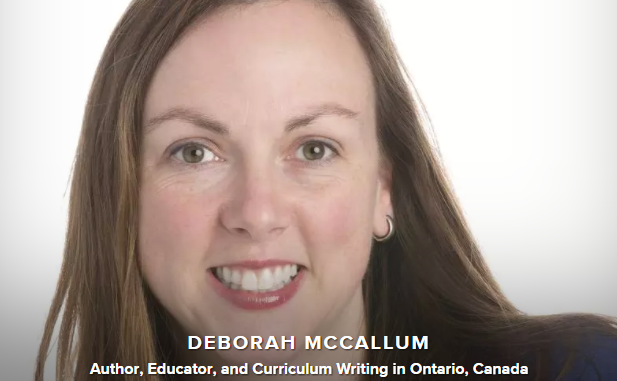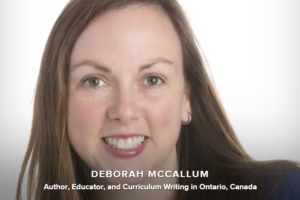
By Deborah McCallum
This paper was part of the proceedings at the Treasure Mountain Canada 5 research symposium and think tank, held in Winnipeg, Manitoba in October, 2017. Deborah McCallum reflects upon how educators must use culturally responsive pedagogy to increase success of students from all cultures, making the case that learning is not “culturally neutral”.
What is identity? It is connected to the groups we affiliate with, the language we use, and who we learned the language from. I believe that each of us has various identities according to the different groups that we belong to, and that this has implications in terms of the languages and discourses we use. For instance, I belong to different groups because I am Canadian, White, English-speaking, and female, and I have experience as an elementary school teacher-librarian, a teacher, and now, a leader with the role of Instruction and Assessment Facilitator.
What is important is that I recognize the intersection of my identity with identities embodied within the Ontario Public School system, my school board, and the schools and students that I work with. In identifying this intersection, I question whether I, as a White, female, Canadian, English-speaking person, can adequately facilitate the increase of assessment scores in math for students who have different identities and cultural groups. I think that this is a question that most of us ask.
Culturally responsive pedagogy (CRP) is one way to begin to address this question and forge a path forward. Inherent in CRP is the idea that we as educators will continue to use students’ culture to transcend the negative effects of the dominant culture. CRP becomes a tool to explain how we can develop a deeper knowledge of students’ cultures, and thus use cultural referents to increase opportunities for student learning. I see an opportunity to engage in inquiry, focus on what is important to each particular student, and to facilitate questions about how to bridge students’ knowledge and experience and Ontario-based standards. However, I still have concerns about how to build cultural competence as a white female, while at the same time helping teachers prepare all students for higher achievement. As academic achievement is often equated more with test scores than with student learning (Milner, 2011), it is important to actively challenge the pressures to focus on test scores, and understand that a standardized test is just one type of outcome for student learning. It is also valuable to help students and teachers to move beyond the spaces where we simply consume knowledge, into spaces where we can critically examine mathematical knowledge via collaborative inquiry.
The Framework for a Culturally Responsive and Relevant Pedagogy (Centre for Urban Schooling, n.d.) outlines several main tenets that need to be in place, including classroom climate and instruction, where the curriculum is anti-racist and speaks to the lives of the students; school climate, where schools support safe spaces and promote physical and psychological health; family and school relations, where families are invited to participate and are used as educational resources; school leadership, where the administration clearly communicates a vision of equity and social justice to all stakeholders; community connections, where school has policies and practices to ensure it learns from knowledge of community members and agencies; and a culture of professional development, where staff are encouraged to learn about students and to focus on their own social identities and privileges. However, the complexities of being a white, middle-class teacher go much deeper than ensuring that we are fulfilling this framework. For example, how do I know that I am actively supporting a safe school environment, and not just thinking that I am because the school environment suits my own identity and the dominant culture? Although we acknowledge the importance of cultural competence, we are less clear about the kinds of experiences that help to build it (Milner, 2011). Thus, I think it will be important to help our collaborative inquiry teams to situate our own privileges, oppressions, and assumptions about student mathematical learning. It will also be necessary to understand the unique sociopolitical underpinnings of our own positions, and the narratives associated with our own identities, before attempting to understand those of our students.
For instance, Ontario’s Renewed Math Strategy requires us to learn the languages and narratives of our students’ identities, and check out our own, and delve deeply into the language inherent in the curriculum itself. This is essential to helping create the necessary discourses and experiences that will lead toward higher achievement. The process that Henze & Arriaza (2006) discussed in their article provides excellent suggestions about how schools and boards board can proceed with future inquiries by following Henze and Arriaza’s (2006) excellent suggestions, beginning with vignettes and awareness-building activities to stimulate further learning. We can then set norms, provide the learning intentions, vocabulary that is important, pose open-ended questions, and collect our assessment data. Then we can collaborate to analyze our data and discuss possible interpretations. Further, we can suggest alternatives and changes that could be made. When we continually share results, plan new lessons and assessments, and continue our cycles of inquiry, the identities of our students and other learners are placed at the forefront of our practice.
This is not without challenges however. Just as it is important to recognize our own languages and identities and thinking about how they intersect with those of other learners, this can cause a great deal of discomfort and cognitive dissonance. Thus, some educators will feel less confident in the processes, some will remain silent, and some may express resentment or even hostility (Henze & Arriaza, 2006). Therefore, we can help foster collaborative inquiries that are about changing the learning cultures (discourses of education), rather than changing the individual teachers or students (discourses of the individual). CRP can be used to help co-create new languages that can help us shape our understandings of different cultures, contexts, and sensitive issues. It will be helpful to have agreed-upon norms, and to exercise them in ways that help us to foster truth and respect. Agents never act alone (Skerrett, 2009).
There are also tensions that can be created in how we view teaching and learning. For instance, it is not uncommon for us to feel individual discomfort or encounter misunderstandings with others when we attempt to incorporate multiple political and socio-ideological views on education (Skerrett, 2009). As a result, we as educators may struggle to resolve this dissonance by focussing on a “purist” views of teaching and learning. Yet, it is important to hear the identities and cultures of our students, in order to ask better questions about how we can facilitate learning, versus finding the ‘pure’ and correct answers.
I think it would be beneficial to explore the master narratives that we hold of individuals from different cultures. Then we can explore how we infer or assume how someone of that sort can be expected to behave or is supposed to behave (Stonebanks & Sensoy, 2011). It is important to also examine this on my own, and to identify the ways in which I use narratives and plots to uphold my own privilege and oppression.
Zembylas (2010) provided insights into how shared schools from conflicting communities draw from selective discourses and practices on collective identity and ethnic conflict in Cyprus. In Ontario, we can see that Canada has a history of experience with colonizers conflicting with Indigenous communities, and we have heard stories about divided countries from students and families who are refugees. However, shared schools that specifically integrate co-existence of divided societies are not the norm here in Ontario. Colonial values and beliefs continue to play a strong role in family and schooling in Canada, and many teachers unconsciously make assumptions based on these values and beliefs. However, it is still possible to apply critical multicultural theory to our Ontario school system, and to analyze the power relations involved in our policies and practices. Zembylas discussed bipolar differences among students, and posed an excellent question of whether school systems in Cyprus de-emphasize bipolar differences. I can ask the same question of our school system here in Ontario. Do we actively explore alternative curricula, policies, and pedagogical practices that create opportunities for critical dialogues, so that we can truly cultivate and nurture empathy, multi-perspectivity, solidarity, and social justice?
Conclusion
Culturally responsive education is important to supporting student learning. As a white educator, who is female, middle class, English speaking, and Canadian, it will be very important for me in my role next year to be aware of other teachers’ perceptions, as well as students’ families, immigration histories, interests, activities, strengths, and concerns. By facilitating and engaging in collaborative inquiries with other teachers, I can also strive to capitalize on the wealth of knowledge about culture that students bring to the teaching and learning processes. It is also important to facilitate the creation of math opportunities that allow students to discuss their own aspirations for the future, by noting how students solve problems, and sharing the different ways that problems are solved. I can strive to move away from relying on my own identity and personal experiences to make sense of how math should be solved in the classroom. In this way, I recognize that math is culturally defined, and that I can change the narrative that I learned from the dominant culture—that math is a pure subject that has the correct answers.
Although I can read about and engage in the strategies that demonstrate a CRP, I perhaps most need to be aware of whether I am implementing the strategies through a social justice lens, or merely filtering them through the lenses of my own privilege and identity. Learning is not culturally neutral, and it will be my challenge to implement a CRP that helps students to understand curriculum in ways that will allow them to succeed and transfer their learning to many situations.
References
Centre for Urban Schooling. (n.d.). Framework for a culturally responsive and relevant pedagogy. Retrieved from http://cus.oise.utoronto.ca/UserFiles/File/CUS%20Framework.pdf
Milner, H. R., IV. (2011). Culturally relevant pedagogy in a diverse urban classroom. Urban Review, 43, 66−89. doi:10.1007/s11256-009-0143-0
Henze, R., & Arriaza, G. (2006). Language and reforming schools: A case for a critical approach to language in educational leadership. International Journal of Leadership in Education, 9, 157−177. doi:10.1080/13603120600697387
Skerrett, A. (2009). Biographical orientations to secondary English teaching within a mosaic context of diversity. English Education, 41, 281−303.
Stonebanks, C. D., & Sensoy, O. (2011). Schooling identity: Constructing knowledge about Islam, Muslims and people of the Middle East in Canadian schools. International Journal of Critical Pedagogy, 3(3), 71−88.
Zembylas, M. (2010). Negotiating co‐existence in divided societies: Teachers, students and parents’ perspectives at a shared school in Cyprus. Research Papers in Education, 25, 433−455. doi:10.1080/02671520903156603
 Deborah McCallum is an author and educator from Ontario. She share her thinking on her blog, Big Ideas in Education.
Deborah McCallum is an author and educator from Ontario. She share her thinking on her blog, Big Ideas in Education.